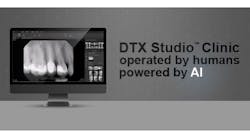Continuity between all dental imaging investments is a key component of clinical and business best practice. All modalities must blend together for the doctor to have the full diagnostic picture and for the patient to understand the reasons to accept treatment.
This is where DTX Studio Clinic comes in. Created by DEXIS, this platform streamlines and simplifies diagnostics and patient data in one connected AI-powered ecosystem. With disparate imaging technologies, some information can become lost or overlooked, creating a mix of steps that interrupts a smooth workflow. DTX Studio Clinic merges, organizes, and displays 2D intraoral and extraoral x-rays, CBCT, IOS, and clinical photos in one place. Images can come from any system and be displayed in any operatory on a Mac or PC.
Many useful features can be activated with a click, such as SmartFocus, which uses tooth positions as a reference to browse by tooth number across 2D and 3D images from different devices and sessions. The dentist can access entire patient histories for each specific tooth. MagicSort auto-positions 2D intraoral x-ray images through automatic recognition and identification of tooth positions in doctor-specified radiographic mounts. SmartLayout offers the flexibility to combine and visualize different images of various types side-by-side on the screen, allowing full diagnostic and treatment view. SmartFusion automatically merges models from CBCT scans and intraoral and desktop scanners. And MagicAssist for CBCT has automatic nerve canal identification, making set-up easy and fast. All of this simplifies your hardware and software needs and creates efficiencies.
DEXassist: 2D AI findings detects and labels findings on 2D intraoral x-rays, such as caries, apical lesions, and bone loss, which the doctor can either designate as a focus area or ignore. It also provides individualized diagnostic visualization, leading to greater understanding of the need for treatment that just a discussion cannot provide.
Imagine a patient comes in with an x-ray showing a possible periapical radiolucency on their upper right central incisor. You drag the x-ray into the patient chart and take a CBCT directly in the software. These images are then unified through SmartFocus recognition. With one click on tooth no. 8, in either the 2D x-ray or the 3D scan, a comprehensive view of both modalities appears in the workspace with the 3D scan centered on the pulp and aligned down the long axis of the tooth. You can now use this to quickly and easily share this comprehensive view of the case to your patient. Not only does this offer a thorough diagnostic view, but it also allows your patient to better understand the etiology of the concern as you present treatment options.
DTX Studio Clinic’s standardized processes and workspaces lead to efficient workflows for general practices as well as specialties. For implant practices, it offers virtual tooth set-up and implant planning as well as automated surgical guide creation. For multispecialty practices, there are TMJ, endodontic, and airway workspaces. Clinicians can share images and findings with partners, referring dentists, and labs in a secure manner.
This system unifies and lets all technologies shine, blending all of the clinician’s technological investments creates a more effective use of all of the information, both for the dentist and the patient.
Editor's note: This article appeared in the April 2025 print edition of Dental Economics magazine. Dentists in North America are eligible for a complimentary print subscription. Sign up here.








